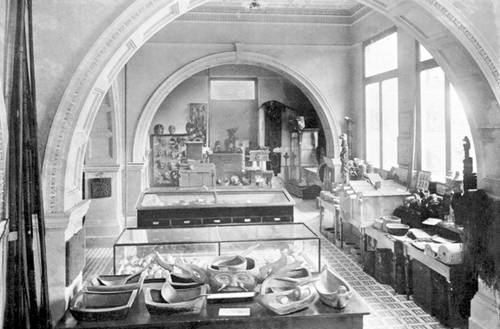The Royal British Columbia Museum and Archives: Tracking It All in British Columbia – Caroline Davies Posynick (September 2018)

The Royal BC Museum and Archives, located in Victoria, British Columbia, Canada, collects British Columbia‘s natural history (botany, entomology, herpetology, ichthyology, invertebrate zoology, mammology, ornithology and paleontology) and human history (archaeology, ethnology and modern history), as well as encompassing the provincial archives. The diverse documents, specimens and artifacts that comprise our collection have very different documentation needs. How do we keep track of them all?

Ethnological Department of the Provincial Museum of Natural History, 1909. BC Archives I-61549
First, a little history. The Royal BC Museum was founded when a group of concerned citizens petitioned the provincial government to ensure that British Columbia’s natural and anthropological riches were preserved and protected against removal from the province. They convinced the government to provide space for a museum in the legislative buildings, and the new museum opened in December 1886. The provincial archives grew out of the province’s Legislative Library, which was founded in 1893; today the BC Archives is the official repository for BC government records as well as the home of the documentary and photographic history of the province. Over the years, each discipline at the museum and archives developed its own distinctive philosophy of collecting and recording, using a variety of registers, spreadsheets and databases.
In 2003 the museum and archives merged, and an effort to unify all the provincial collections in one entity began. But it wasn’t until 2008 that a registration department was created to centralize the tracking of everything that comes into the collections. We track the wide variety of items coming into the Royal BC Museum, ultimately handing them over to individual collections areas for documentation and physical care. As the senior registrar, it is one of my responsibilities to manage the process and procedures that guide the diverse items entering the institution’s collection.
All items that enter our collection must pass through a collections committee. As the provincial repository for archeological and paleontological finds, we receive some items on an information basis. Our natural history staff also conduct field research projects to collect British Columbia botanical and faunal voucher specimens—examples of species that occur in our province. Government records pass through the collections committee too—once again, we are the provincial repository for these records. Items that are only brought in after discussion are considered selective acquisitions; collections staff provide the committee with information on the authenticity of such items, their relevance to the collection and whether or not we have the resources to care for them. Given the diversity of items that come forward for review and approval, the wide variety of conversations at our collections committee meetings isn’t surprising!

The Provincial Museum’s first curator/director, John Fannin, was an avid naturalist and taxidermist as well as the organizer of the early collection. BC Archives G-03172
All collections items—whether deposits or selective acquisitions—are registered in a custom-designed centralized database, with the first entry in the Registration module. The basic information is the same for all items: the name of the item, the source, the date of arrival and the specific collection area that it will enter if it is approved by the collections committee and accessioned. All museum artifacts and specimens and their associated information are forwarded to the correct section in the database for cataloging by museum staff specializing in the collection area; archives materials are accessioned and then catalogued by archivists in a separate database.
With so many types and categories of objects in our collections, objects which share only the characteristic that they are relevant to our understanding of British Columbia’s history, registration presents a unique challenge. But our centralized database, our systematic but flexible approach and the expert opinions provided by our collections staff, whether they work with textiles, toads or totem poles, keep the system working.
Bio:
Caroline Davies Posynick has a master of arts in museum studies, specializing in collections management, and has worked with collections for more than 25 years. Caroline has been the senior registrar at the Royal BC Museum since January 2015 and welcomes your comments at cdaviesposynick@royalbcmuseum.bc.ca. You can see some of the Royal BC Museum’s collection and its variety in this two-and-a-half-minute video about the challenges of identifying the first item to enter the collection.